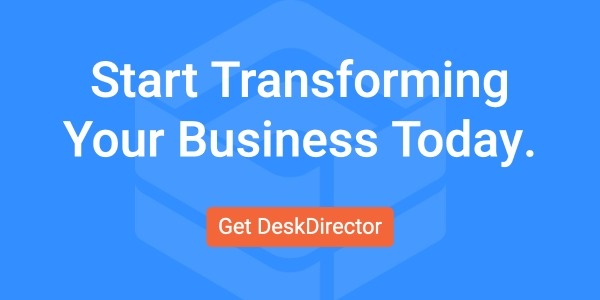Which of the following would give you more joy: a great radio station, or a personalized playlist?
This is essentially the choice you face when using DeskDirector’s tech portal.
While the out-of-the-box solution provides everything you need to produce an efficient and effective ticketing system, there is deeper value to be found in configuring your system.
In this article, we explain why configuring your tech portal with a customized set up is so important – and which tools will have the largest impact on your workflows.
Why You Need to Configure DeskDirector for Your Organization
Every organization operates differently, with its own culture and approach to IT. Ticketing systems exist to support and enhance your specific operations, which means every ticketing system will be subtly different.
Configuring DeskDirector empowers you to design and implement processes that fit your specific needs. Tickets can be created, handled and resolved in a way that makes sense for your organizational structure and unique tech teams.
7 Essential Tools to Configure in DeskDirector
1. Request types
Imagine receiving six different tickets, all using different languages to describe the same basic problem: the end-users' emails won’t send. But your techs end up wasting time parsing these different messages rather than solving the problem.
Request types enable you to sort tickets into relevant categories based on the specific problem they indicate. You can create any number of custom request types based on the issues your teams experience. Then you can add descriptions, task templates and custom forms to your request type, so that they automatically appear with any ticket issued within this category.
As a result, you unlock opportunities to automate and streamline workflows, fast tracking important request types and ensuring they are treated in a reliable, uniform manner.
2. Ticket tags
Efficient help desk systems have one thing in common: they get tickets to the right tech as quickly as possible. The key to this is including enough information in your tickets to route them automatically – which is exactly what ticket tags achieve.
Ticket tags are specifications that clarify its content. This could be the company, contact, request type or a range of other factors - as well as any custom tag your organization needs.
Configuring them allows end-users and techs to include key information that techs can view at a glance. This accelerates the workflow and allows for specific combinations of tags to be automatically routed to specific techs or given priority.
3. User groups
User groups are technically another form of tags, but they are so useful they deserve their own specific category. Configuring groups allows you to automatically make specific tickets visible to a particular group of users and customize the permission sets for users within a group.
For example: the head of HR may be required to approve tickets sent from their department. You can therefore configure a group called ‘HR’, and attach the tag to any relevant ticket – and these tickets will be automatically sent to the head of HR.
User groups also prevent end-users' portals from being cluttered; they will only see the tickets that are tied to their user group instead of seeing all open tickets within the company’s DeskDirector instance.
4. Task lists
Task lists are an essential part of the standard ticketing process. But with DeskDirector, you can customize your task lists and embed them as SOPs into tickets, depending on their type.
This unlocks a level of consistency most organizations can’t achieve, while also accelerating your ticketing workflows. Plus, it allows you to adapt your task lists over time as your operating model evolves.
5. Macros
Given that manual tasks can take up around 40% of your employees’ time, most organizations look to automate repetitive tasks. But the majority still rely on out-of-the-box automations, which means techs still lose valuable time writing rote replies to messages or assigning tickets.
DeskDirector’s macros allow you to create custom automations. You can configure standard replies to be sent when specific triggers occur or assign tickets to specific techs based on their tags.
6. Notifications
Notifications are essential to keep your techs and end-users updated on the progress of tickets. However, receiving too many notifications can harm your productivity - especially if they are irrelevant to your work.
DeskDirector allows you to configure your notification settings so that only specific users receive them. All you need to do is specify which triggers you would like to notify users on, and these rules will be applied automatically based on the tags on your ticket.
Individual users can also customize their notification settings on a personal level, ensuring that they are receiving updates in a method that is most conducive to their workflow.
7. Reporting
Ticketing analytics are a rich source of insight for IT organizations. But the standard data you receive through most platforms is not sufficient to unlock a deep understanding of how your ticketing system works.
However, DeskDirector’s Microsoft BI integration enables you to move from traditional reporting to true business intelligence. You can build custom reports and dashboards directly in Microsoft BI that use data from DeskDirector to reveal meaningful trends in your ticketing system usage and end-user behavior.
Take Control of Your Ticketing System with DeskDirector
DeskDirector is trusted by many of the world’s most impactful companies to keep their IT systems running. But the true value of our platform is not who uses it, but how.
With all these configuration options, we enable IT leaders to build the perfect system for their organization – leading to a 20% increase in usage and 400% faster ticket resolutions.
Want to see how it could transform your ticketing system?









